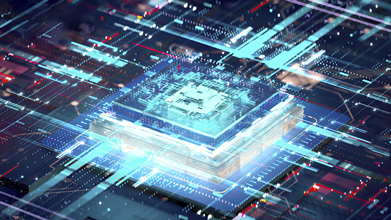SUNNYVALE, Calif.—September 12, 2017— Real-Time Innovations (RTI), the Industrial Internet of Things (IoT) connectivity company, today announced the first connectivity software designed to build layered-databus architectures for IIoT systems of systems: RTI Connext® DDS 5.3.
Typical IIoT systems require sharing data across multiple networks, from the edge to the fog to the cloud. For example, in a connected hospital, devices have to communicate within a patient or operating room, to nurses’ stations and off-site monitors, to real-time analytics applications for smart alarming and clinical decision support, and with IT health records. This is challenging for several reasons. The aggregate volume of streaming device data could easily overwhelm hospital networks. Patient data must be securely tracked, even as patients and devices move between rooms and networks. Additionally, devices and applications have to interoperate, even when developed by different manufacturers.
To help system architects address these challenges, the Industrial Internet Consortium (IIC) recently released the Industrial Internet Reference Architecture (IIRA). The IIRA identifies a Layered Databus pattern as the recommended framework for developing these multi-tiered IIoT systems of systems. RTI Connext DDS 5.3 is the first connectivity software designed to implement the layered databus pattern while also fostering interoperability and an open architecture.
“At Spirae we are working with our customers to build management and control systems for distributed energy resources that require different components to exchange secure messages about the assets they’re controlling – from batteries to conventional generators to wind turbines – and back to other power system operational systems,” said Holger Kley, product manager at Spirae. “We selected RTI Connext DDS as the connectivity software for our platform due to its advanced security, flexibility to configure different Quality of Service profiles, brokerless architecture and the diagnostic and monitoring tools. Our customers have critical infrastructure and with RTI’s industry leading technology as the backbone of the Spirae Wave platform, we’re able to offer a proven secure and reliable solution now and for the future.”
Interoperable Security
Built on the Object Management Group (OMG) Data Distribution Service (DDS) standard, Connext DDS 5.3 introduces support for the recently finalized DDS Security standard. As a result, devices and applications developed with Connext DDS 5.3 will interoperate with those that take advantage of future Connext DDS versions. Given the long lifecycle of IIoT systems, forward interoperability is essential for products that cannot be easily upgraded once they are deployed. In addition, RTI verified Connext DDS 5.3 interoperates with other DDS Security implementations, enabling plug-and-play systems that incorporate components from multiple suppliers.
“Scalable and secure connectivity is a crucial component driving the Industrial Internet’s momentum,” said David Barnett, vice president of products and markets at RTI. “With the introduction of Connext DDS 5.3, we are making it easier for developers to ensure their systems can handle the complex performance and scalability requirements of the Industrial IoT, while integrating the level of security necessary for critical applications. This reduces costs for our customers by simplifying development and integration. At the same time, it also enables interoperability in the greater IIoT market. At RTI we are proud to help our customers lead their respective markets as they expand their IIoT systems, now and for years to come.”
Historical Data Query
IIoT applications often need access to historical data to refine analytics or update dashboards. Due to the large amount of data in IIoT systems of systems, it is rarely possible to send all data to all locations. Connext DDS 5.3 now provides the capability to request and receive historical data as efficiently as live data. Additionally, the ability to filter for specific content, such as requesting a patient’s body temperature over the last 4 hours, prevents the network bandwidth from flooding.
Seamless Device Mobility
In IIoT systems, it is critical that your systems maintain connectivity even as devices roam across networks, such as in autonomous cars. Because different networks assign different addresses, traditional approaches cause a loss in connectivity and data during the switchover. With Connext DDS 5.3, devices automatically and securely re-locate and re-authenticate to maintain uninterrupted connectivity when a network address changes.
RTI Connext DDS 5.3 and the layered-databus architecture have applications across industries, including healthcare, energy, aerospace and defense (A&D) and transportation.
Developers can take advantage of the Connext DDS connectivity framework, software development kits (SDKs), tools and runtime services to intelligently design, build and deploy their IIoT systems. Additional new features and benefits include:
- RTI Web Integration Service: Provides an easy way to build user-facing web applications. It provides a RESTful interface to the Connext Databus based on the OMG Web-Enabled DDS specification.
- RTI Gateway Toolkit: Bridges and interoperates with legacy technologies, as well as other standards-based connectivity frameworks, such as OPC-UA, and messaging protocols, such as MQTT and AMQP.
- RTI Administration Console: Works with the new security capabilities to provide insight into secured data while monitoring, controlling and debugging from a centralized tool.
All of the standard Connext DDS components have been enhanced to be compatible with the new and advanced DDS Security standard. Connext DDS 5.3 is immediately available. For inquiries and pricing, contact sales@rti.com. For more information on RTI Connext DDS, the layered databus architecture and a full list of new features, please visit https://www.rti.com/products/dds.
About RTI
Real-Time Innovations (RTI) is the Industrial Internet of Things (IIoT) connectivity company. The RTI Connext® databus is a software framework that shares information in real time, making applications work together as one, integrated system. It connects across field, fog and cloud. Its reliability, security, performance and scalability are proven in the most demanding industrial systems. Deployed systems include medical devices and imaging; wind, hydro and solar power; autonomous planes, trains and cars; traffic control; Oil and Gas; robotics, ships and defense.
RTI lives at the intersection of functional artificial intelligence and pervasive networkingSM.
RTI is the largest vendor of products based on the Object Management Group (OMG) Data Distribution Service™ (DDS) standard. RTI is privately held and headquartered in Sunnyvale, Calif.
RTI is hiring aggressively; see www.rti.com/careers.





